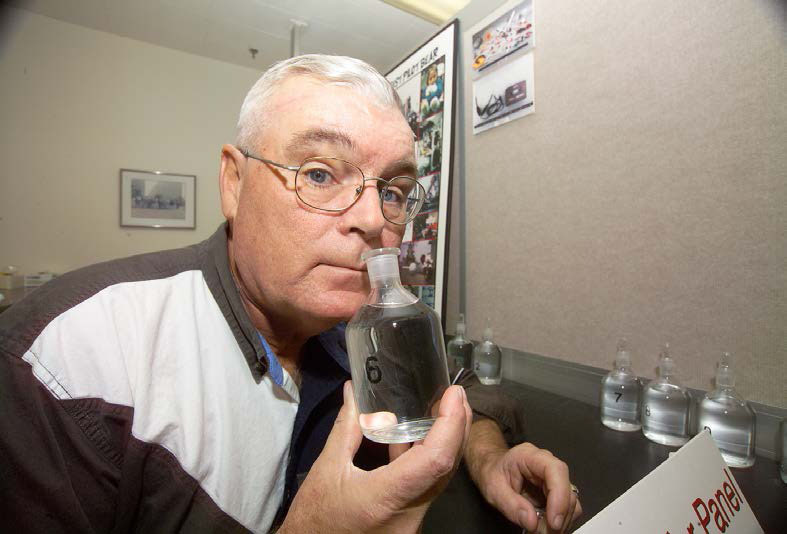NASA-L
Almost all of us have been on, say, a bus or some similarly enclosed space, and — P.U.! — there’s something out there which smells putrid. And because you’re on a bus (to continue with the example), there’s not much you can do — it’s not like you can open the window. Thankfully, the pungent bus ride is a very temporary situation. In most cases, the odor is a mild inconvenience.
But what if you were in that enclosed space for, oh, a few weeks? Or even a few months? In that case, the odors and aromas of your surroundings would be critical to your well-being. And that’s where this guy steps in.

That’s NASA employee George Aldrich. His job? To smell things before they go into space.
Space stations, shuttles, and the like are all enclosed spaces — one where almost everything is recycled (see the “From the Archives” link today) due to the isolation and lack of external atmosphere. So we need to take great care when we send people or things into such environments. That’s where Aldrich comes in.
Officially, Aldirch is a “Chemical Specialist” at NASA’s White Sands Test Facility in New Mexico, which “tests and analysis potentially hazardous materials, components, and systems.” But, really, his job is to sniff around for things that probably shouldn’t make the trip upward. And he’s well-suited to the task. In the 1970s, Aldrich was a firefighter in the White Sands area when he learned that NASA was looking for stink detectors. Aldirch, per OddityCentral, “has had a superior sense of smell since childhood” and applied for the role — and was quite successful. OddictyCentral continues: “He did exceedingly well at their calibration test in which he had to identify the seven primary odors – musky, minty, floral, ethereal, camphoraceous, pungent and putrid.” And he’s maintained the skill since — NASA re-tests his sense of smell every four months.
He’s not alone in the endeavor — per NASA, Aldrich leads a team that “tests nearly all items that astronauts would encounter during their flight — including fabric, toothpaste, circuit boards, makeup and even the ink on their checklists. ” And then, they decide whether the item can go skyward:
Aldrich and four other team members smell the items and rank them on a scale of zero to four, ranging from non-detectable (zero), to barely detectable, easily detectable, objectionable and offensive (four). Aldrich refers to level four as “get-me-out-of-here.” Because the sense of smell can vary from person to person, sniffers give each object its own ratings, from which an average is obtained. If an item rates more than a 2.4 on the scale, it fails the test and is not allowed on the flight. Some items that have failed are camera film, felt-tipped markers, mascara and certain types of stuffed animals. Aldrich has done 765 of these “smell missions” to date.
And no, this isn’t overkill on NASA’s part. A bad smell can — and probably has — caused the abrupt end of at least one space mission on record. In 1976 — around the time Aldrich was first hired by NASA — a Russian mission to the Salyut 5 space station was terminated abruptly. As Wikipedia notes, “the precise reason for the early end of the mission was the subject of much speculation, but was reported to be an emergency evacuation after the Salyut atmosphere developed an acrid odor.”
Bonus fact: One of the awards Aldrich has earned for his NASA service is the Silver Snoopy, “a special honor awarded to NASA employees and contractors for outstanding achievements related to human flight safety or mission success ” per Wikipedia. The award is named for the Peanuts character Snoopy. Recipients, per NASA, receive “a sterling silver Snoopy lapel pin that has flown on a Space Shuttle mission, plus a certificate of appreciation and commendation letter for the employee, both signed by the astronaut. ” (An image of the pin — a smiling Snoopy in astronaut gear — can be seen at that link.) The idea for the award came from a NASA employee who was a Snoopy fan. Snoopy’s creator, Charles M. Schulz, was a fan of space exploration and offered to license the character to NASA for free.
From the Archives: Keeping the P in Space: Astronauts drink what they previously drank. And they’re happy about it.
Related: I couldn’t find a smell testing kit, but here’s one that will test your sense of taste. And it’s only $15.
